Nymphalis
Tortoiseshells and Mourning Cloaks
Andrew V. Z. Brower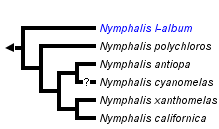


This tree diagram shows the relationships between several groups of organisms.
The root of the current tree connects the organisms featured in this tree to their containing group and the rest of the Tree of Life. The basal branching point in the tree represents the ancestor of the other groups in the tree. This ancestor diversified over time into several descendent subgroups, which are represented as internal nodes and terminal taxa to the right.

You can click on the root to travel down the Tree of Life all the way to the root of all Life, and you can click on the names of descendent subgroups to travel up the Tree of Life all the way to individual species.
For more information on ToL tree formatting, please see Interpreting the Tree or Classification. To learn more about phylogenetic trees, please visit our Phylogenetic Biology pages.
close boxIntroduction
A holarctic group of fast flying nymphalids. Some overwinter as adults (e. g., N. antiopa) and may be seen flying on warm days in late winter.Discussion of Phylogenetic Relationships
The hypothesis of relationships is that implied by the combined analysis of mitochondrial and nuclear genes by Wahlberg et al. (2009). The position of the unsampled N. cyanomelas, a Mexican endemic, is hypothesized based on its morphological similarity to N. antiopa.References
Wahlberg, N. & Nylin, S. 2003 Morphology versus molecules: resolution of the positions of Nymphalis, Polygonia, and related genera (Lepidoptera: Nymphalidae). Cladistics 19, 213-223.
Wahlberg, N., Weingartner, E., Warren, A. D. & Nylin, S. 2009 Timing major conflict between mitochondrial and nuclear genes in species relationships of Polygonia butterflies (Nymphalidae: Nymphlalini). BMC Evolutionary Biology 9, 92.
Title Illustrations

| Scientific Name | Nymphalis polychloros |
|---|---|
| Specimen Condition | Live Specimen |
| Source | Nymphalis polychloros |
| Source Collection | Flickr |
| Image Use |
 This media file is licensed under the Creative Commons Attribution-NonCommercial-NoDerivs License - Version 2.0. This media file is licensed under the Creative Commons Attribution-NonCommercial-NoDerivs License - Version 2.0.
|
| Copyright | © 2006 javig |
| Scientific Name | Nymphalis californica |
|---|---|
| Location | Boulder Creek, California, USA |
| Comments | These California Tortoiseshells are all over our yard in Boulder Creek, California. There were nearly 100 of them this morning in the air and on the wet ground (they seem to like water) along with several California Sisters and smaller lilac-colored butterflies. We have not experienced this quantity of butterflies in 10 years we've lived here. |
| Creator | Photo by Vicki Rogers |
| Specimen Condition | Live Specimen |
| Source | Nymphalis californica |
| Source Collection | Flickr |
| Image Use |
 This media file is licensed under the Creative Commons Attribution-NonCommercial-ShareAlike License - Version 2.0. This media file is licensed under the Creative Commons Attribution-NonCommercial-ShareAlike License - Version 2.0.
|
| Copyright | © 2007 Vicki & Chuck Rogers |
| Scientific Name | Nymphalis antiopa |
|---|---|
| Location | Oak View, California, USA |
| Specimen Condition | Live Specimen |
| Source | Mourning Cloak Butterfly |
| Source Collection | Flickr |
| Image Use |
 This media file is licensed under the Creative Commons Attribution-NonCommercial-NoDerivs License - Version 2.0. This media file is licensed under the Creative Commons Attribution-NonCommercial-NoDerivs License - Version 2.0.
|
| Copyright | © 2006 Aleta Rodriguez |
About This Page

Middle Tennessee State University, Murfreesboro, Tennessee, USA
Correspondence regarding this page should be directed to Andrew V. Z. Brower at
Page copyright © 2009
 Page: Tree of Life
Nymphalis . Tortoiseshells and Mourning Cloaks.
Authored by
Andrew V. Z. Brower.
The TEXT of this page is licensed under the
Creative Commons Attribution License - Version 3.0. Note that images and other media
featured on this page are each governed by their own license, and they may or may not be available
for reuse. Click on an image or a media link to access the media data window, which provides the
relevant licensing information. For the general terms and conditions of ToL material reuse and
redistribution, please see the Tree of Life Copyright
Policies.
Page: Tree of Life
Nymphalis . Tortoiseshells and Mourning Cloaks.
Authored by
Andrew V. Z. Brower.
The TEXT of this page is licensed under the
Creative Commons Attribution License - Version 3.0. Note that images and other media
featured on this page are each governed by their own license, and they may or may not be available
for reuse. Click on an image or a media link to access the media data window, which provides the
relevant licensing information. For the general terms and conditions of ToL material reuse and
redistribution, please see the Tree of Life Copyright
Policies.
- First online 19 April 2009
- Content changed 04 June 2009
Citing this page:
Brower, Andrew V. Z. 2009. Nymphalis . Tortoiseshells and Mourning Cloaks. Version 04 June 2009 (under construction). http://tolweb.org/Nymphalis/70342/2009.06.04 in The Tree of Life Web Project, http://tolweb.org/




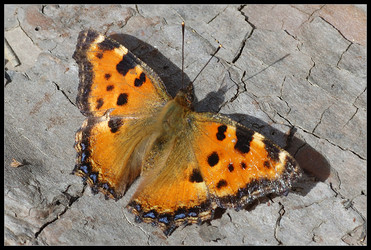
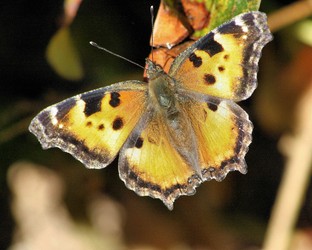
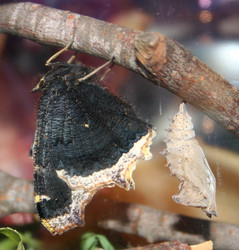
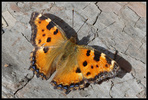
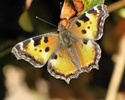


 Go to quick links
Go to quick search
Go to navigation for this section of the ToL site
Go to detailed links for the ToL site
Go to quick links
Go to quick search
Go to navigation for this section of the ToL site
Go to detailed links for the ToL site